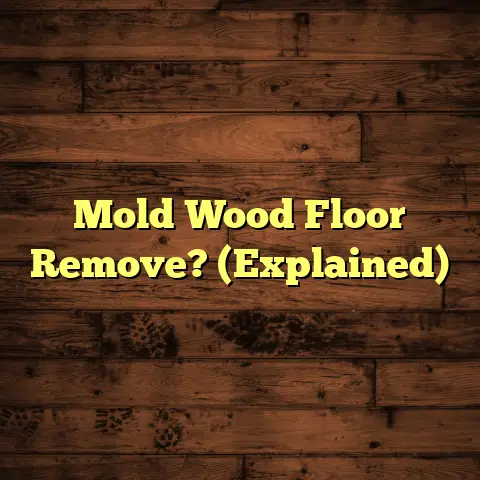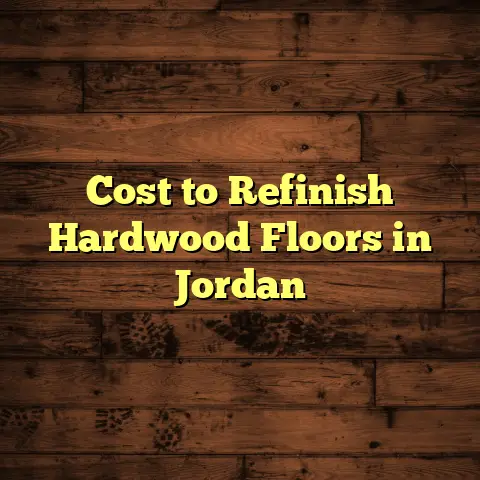Remove Wood Floor Restorer? (5 Minute Fix Guide!)
Today, we’re tackling a common issue: removing wood floor restorer. You know, that stuff promising to bring back the luster to your beloved hardwoods?
Sometimes, it works wonders. Other times, well, let’s just say it can leave you with a less-than-desirable result.
But don’t worry, I’m here to guide you through the process. And believe me, it’s often a quicker fix than you think!
Introduction: Regional Needs
and Preferences
Now, before we dive into the nitty-gritty of removing wood floor restorer, let’s talk about something crucial: location, location, location!
Where you live plays a HUGE role in how your wood floors behave and what kind of maintenance they need.
Think about it: that beautiful oak floor in a cozy cabin in the mountains of Colorado is going to have very different needs than the same floor in a breezy beach house in Miami.
Why? Well, let’s break it down:
-
Humidity: Coastal areas like Florida or the Pacific Northwest are notorious for high humidity. This can cause wood to expand and contract, leading to warping, cupping, or even finish problems. In these regions, you might need restorers specifically designed to handle moisture.
On the other hand, drier climates like Arizona or Nevada can cause wood to shrink and crack. Here, restorers with added oils or moisturizers might be more beneficial.
According to the EPA, indoor humidity should ideally be between 30-50%. (Source: EPA Indoor Air Quality)
-
Temperature: Extreme temperature swings can also wreak havoc on wood floors. Think about those frigid winters in Minnesota versus the scorching summers in Texas. These fluctuations can stress the wood and affect the finish.
-
Lifestyle: Your lifestyle matters too! Do you have kids and pets running around? Are you constantly tracking in dirt and sand? High-traffic areas require more frequent cleaning and maintenance, and you might need a more durable restorer.
-
Local Preferences: Believe it or not, even regional aesthetic preferences can influence flooring choices and maintenance. In some areas, a high-gloss finish is all the rage, while others prefer a more matte, natural look.
So, what’s the takeaway? Before you even think about applying (or removing) wood floor restorer, take a good look at your local climate, your lifestyle, and your personal preferences.
Understanding these factors will help you choose the right products and techniques to keep your wood floors looking their best for years to come.
Alright, now that we’ve covered the importance of regional needs, let’s move on to the good stuff: understanding wood floor restorers!
Section 1: Understanding
Wood Floor Restorers
Okay, so what exactly are wood floor restorers, and what are they supposed to do?
Simply put, wood floor restorers are products designed to revive and protect your hardwood floors. They’re like a quick pick-me-up for floors that are looking a little dull, scratched, or worn.
Think of them as a temporary facelift, not a full-blown renovation.
Here’s a breakdown of the different types you’ll find on the market:
-
Liquid Restorers: These are usually water-based or acrylic-based and are designed to add a layer of shine and protection to your floor. They’re relatively easy to apply and dry quickly.
-
Wax-Based Restorers: These contain wax, which provides a protective layer and a nice sheen. However, they can be more difficult to apply and remove, and they may attract dirt and dust.
-
Oil-Based Restorers: These penetrate the wood to nourish and protect it. They can enhance the natural beauty of the wood and provide a durable finish. However, they may take longer to dry and can have a strong odor.
-
Polyurethane Restorers: These are similar to liquid restorers but offer more durability. They’re resistant to scratches and stains, making them a good choice for high-traffic areas.
So, how do these products work their magic?
Well, most wood floor restorers contain a combination of ingredients that aim to achieve the following:
-
Shine: They contain polymers or waxes that create a reflective surface, making your floors look brighter and more vibrant.
-
Protection: They form a protective layer that helps to shield your floors from scratches, scuffs, and stains.
-
Color Enhancement: Some restorers contain pigments that can enhance the natural color of your wood floors, making them look richer and more defined.
It’s important to remember that wood floor restorers are not a substitute for proper floor maintenance.
Regular cleaning, sweeping, and occasional professional refinishing are still essential for keeping your wood floors in top condition.
But, when used correctly, a good wood floor restorer can be a valuable tool in your floor care arsenal.
Now that you know what wood floor restorers are and what they do, let’s talk about when it might be time to say goodbye to them.
Section 2: Signs That Indicate
the Need for Removal of
Wood Floor Restorer
Alright, let’s get down to brass tacks.
How do you know when that wood floor restorer you so lovingly applied is no longer doing its job and needs to be removed?
Here are some telltale signs to watch out for:
-
Dullness: This is probably the most obvious sign. If your floors have lost their shine and look lackluster, it’s a good indication that the restorer is wearing off or has become clouded with dirt and grime.
-
Uneven Sheen: Are some areas of your floor shiny while others are dull? This could be due to uneven application of the restorer or wear and tear in high- traffic areas.
-
Discoloration: Have you noticed any yellowing, clouding, or other discoloration on your floors? This can be caused by the restorer reacting with sunlight, cleaning products, or the wood itself.
-
Build-Up: If your floors feel sticky, tacky, or have a cloudy film on them, it’s likely that you have a build-up of restorer. This can happen if you apply too much product or don’t clean your floors properly before applying it.
-
Peeling or Flaking: In some cases, the restorer can start to peel or flake off the floor, leaving unsightly patches.
-
Worn-Off Spots: Check high-traffic areas like hallways, doorways, and around furniture. If you see spots where the finish has completely worn off, it’s time to consider removing the restorer and refinishing the floor.
To assess the condition of your floor, I recommend getting down on your hands and knees (yes, really!) and taking a close look.
Use a flashlight to highlight any imperfections or areas of concern.
Run your hand over the surface of the floor to feel for any stickiness, roughness, or unevenness.
Consider asking yourself these question:
- Does the floor look as good as it did when you first applied the restorer?
- Are there any areas that look worse than others?
- Does the floor feel clean and smooth, or sticky and grimy?
If you answered “no” to any of these questions, it’s probably time to consider removing the wood floor restorer.
But why would you need to remove it in the first place? Let’s dive into that next.
Section 3: Why You Might Need
to Remove Wood Floor Restorer
Okay, so you’ve identified that your wood floor restorer isn’t exactly living its best life.
But why can’t you just keep applying more and more layers to try and fix the problem?
Well, there are several reasons why removal might be necessary:
-
Incorrect Application: Let’s face it, we’ve all been there. Maybe you applied too much restorer, didn’t spread it evenly, or forgot to clean the floor properly beforehand. These mistakes can lead to a streaky, uneven, or sticky finish.
-
Build-Up of Layers: As I mentioned earlier, applying multiple layers of restorer over time can create a thick, gummy build-up. This build-up can trap dirt and grime, making your floors look dull and lifeless.
Imagine painting over wallpaper without removing it first. Eventually, the paint will start to crack and peel, taking the wallpaper with it. The same thing can happen with wood floor restorer.
-
Aesthetic Preferences: Sometimes, your taste changes! Maybe you’re tired of the high-gloss finish and want to switch to a more matte look. Or perhaps you’re planning to refinish your floors and want to start with a clean slate.
-
Flooring Requirements: Perhaps you’re preparing your home to sell. Potential buyers are savvy, and a floor with a build-up of product can be a turn-off. A clean, natural-looking floor is often more appealing.
-
Complications with Long-Term Maintenance: Certain types of restorers can actually make long-term maintenance more difficult.
For example, wax-based restorers can interfere with the adhesion of future finishes.
This means that if you ever decide to refinish your floors, you’ll need to remove all traces of the wax before you can apply the new finish.
And trust me, removing wax from wood floors can be a real pain!
So, what’s the bottom line? Removing wood floor restorer isn’t always about fixing a mistake.
Sometimes, it’s about making a conscious decision to improve the look, feel, and long-term health of your wood floors.
Now that you understand why removal might be necessary, let’s get to the part you’ve all been waiting for: the 5-minute fix guide!
Section 4: 5-Minute Fix Guide
to Remove Wood Floor Restorer
Alright, let’s roll up our sleeves and get to work!
I know the title says “5-minute fix,” but let’s be realistic. Depending on the size of your floor and the amount of build-up, it might take a little longer.
But trust me, the results will be worth it!
First, let’s gather our supplies. Here’s what you’ll need:
Materials Needed:
-
Floor Scraper: A plastic or nylon floor scraper is essential for removing the old restorer. Avoid using metal scrapers, as they can scratch the wood. I prefer a scraper with a wide, flat blade for maximum coverage.
-
Cleaning Solution: You have a few options here. You can use a commercial floor cleaner specifically designed for removing wax and build-up. Or, you can make your own solution using a mixture of warm water and vinegar (1 cup of vinegar per gallon of water).
Safety First: Always test any cleaning solution in an inconspicuous area before applying it to the entire floor.
-
Microfiber Cloths: These are your best friends for cleaning and wiping the floor. They’re soft, absorbent, and won’t scratch the wood.
-
Spray Bottle: For applying the cleaning solution.
-
Bucket: For rinsing the microfiber cloths.
-
Gloves: To protect your hands from the cleaning solution.
-
Optional: A soft-bristled scrub brush can be helpful for loosening stubborn build-up.
Got all your supplies? Great! Let’s get started:
Step-by-Step Instructions:
-
Preparation: Clear the area by removing all furniture, rugs, and other obstacles. Sweep or vacuum the floor thoroughly to remove any loose dirt, dust, or debris.
A clean floor is essential for achieving the best results.
-
Testing: Before you go all-in, test your chosen removal method in a small, inconspicuous area, like under a piece of furniture or in a closet. This will help you ensure that the solution doesn’t damage or discolor your floor.
Apply the cleaning solution to the test area, let it sit for a few minutes, and then wipe it away with a microfiber cloth. If the finish comes off easily and the floor looks good, you’re good to go!
-
Application of Removal Solution: Pour your chosen cleaning solution into a spray bottle. Lightly spray the solution onto a small section of the floor (about 4×4 feet).
Don’t saturate the floor with the solution. You want it to be damp, not soaking wet.
Let the solution sit for a few minutes to soften the old restorer. The exact amount of time will depend on the type of restorer and the amount of build-up.
I usually wait about 3-5 minutes, but you may need to experiment to find the sweet spot.
-
Scraping and Wiping: Using your floor scraper, gently scrape off the softened restorer. Hold the scraper at a slight angle and use smooth, even strokes.
Work in the direction of the wood grain to avoid scratching the floor.
As you scrape, you’ll notice the old restorer coming off in flakes or sheets. Wipe up the residue with a clean microfiber cloth.
Rinse the cloth frequently in your bucket of clean water.
-
Final Cleaning: Once you’ve scraped and wiped the entire floor, it’s time for a final cleaning.
Fill your spray bottle with clean water and lightly mist the floor. Wipe the floor again with a clean microfiber cloth to remove any remaining residue.
For stubborn areas, you can use a soft-bristled scrub brush to gently scrub the floor.
Make sure to rinse the brush frequently to avoid spreading the residue around.
And that’s it! You’ve successfully removed the old wood floor restorer.
Now, let’s talk about what to do after the removal process.
Section 5: Post-Removal Care
Congratulations, you’ve successfully removed the old wood floor restorer!
But the job’s not quite done yet. Here’s how to care for your floors after the removal process:
-
Allow the Floor to Dry Properly: This is crucial! After the final cleaning, allow the floor to dry completely before walking on it or replacing any furniture.
Open windows and doors to improve ventilation and speed up the drying process.
Depending on the humidity and temperature, it can take anywhere from 30 minutes to a few hours for the floor to dry completely.
-
Conditioning or Refinishing: After removing the restorer, your floors may look a little dry or dull.
If your floors are in good condition overall, you can apply a wood floor conditioner to nourish and protect the wood.
Choose a conditioner that is specifically designed for your type of wood floor and follow the manufacturer’s instructions.
If your floors are heavily scratched, worn, or damaged, you may need to consider refinishing them.
Refinishing involves sanding down the existing finish and applying a new coat of stain and sealant.
This is a more involved process, but it can completely transform the look of your floors.
-
Maintenance Tips: To keep your wood floors looking their best after removing the restorer, follow these maintenance tips:
- Sweep or vacuum regularly to remove dirt and debris.
- Clean spills immediately to prevent staining.
- Use a damp (not wet) mop to clean the floor.
- Avoid using harsh chemicals or abrasive cleaners.
- Place mats at entrances to trap dirt and moisture.
- Use furniture pads to protect the floor from scratches.
- Consider applying a new coat of wood floor restorer every few months to maintain the shine and protection.
By following these post-removal care tips, you can ensure that your wood floors stay beautiful and healthy for years to come.
Conclusion
So, there you have it! A comprehensive guide to removing wood floor restorer, complete with a 5-minute fix guide and post-removal care tips.
Remember, understanding your regional needs is crucial for choosing the right products and techniques for your wood floors.
By taking the time to properly maintain your floors, you can extend their lifespan and enjoy their beauty for years to come.
And don’t be afraid to experiment and find what works best for you.
Every wood floor is different, and what works for one person may not work for another.
But with a little knowledge and effort, you can keep your wood floors looking their absolute best.
Happy flooring!





